The HRD stump treatment guidelines are now available in an interactive format to make it easier to obtain stand-specific recommendations. You can find the link called “Interactive guidelines” on the right side bar under “Additional Resources” at the DNR HRD webpage. The user will be asked a series of questions and then a stand-specific recommendation will be provided at the end. The interactive guidelines incorporate Exceptions and Modifications described in the guidelines. Check it out!
Central WI Forest Health
Reports of sudden balsam fir mortality
Linda Williams, forest health specialist, Woodruff, Linda.Williams@wisconsin.gov, 920-360-0665
In early June we started getting reports of balsam fir trees rapidly changing from green to rusty red and dying in just a matter of weeks. Reports and observations are still coming in at the time of this writing, so this article gives a brief synopsis of what we’ve seen so far this year. Symptoms have been observed in some northern and central counties.
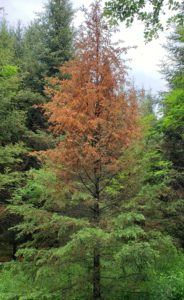
Some balsam fir crowns died rapidly this spring for reasons still being explored.
Report surviving elm in the forest
You can help keep native elm trees in the forests of Wisconsin! The US Forest Service continues to work on a project to identify Dutch elm disease (DED)-tolerant American elms native to Wisconsin forests. The goal of the project is to identify and propagate survivor American elms, especially from the colder hardiness zones 3-4, and develop a series of clone banks. Selections would eventually be screened for tolerance to DED. Ultimately, the goal is to make DED-tolerant American elm available for reforestation in northern areas, particularly as a component on sites currently forested by black ash.
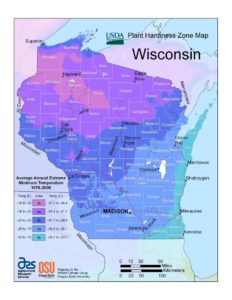
If you live in hardiness zones 3 and 4, please look for evidence of surviving elms and report them to the US Forest Service.
Updated emerald ash borer silviculture guidelines now available
By Bill McNee, forest health specialist, Oshkosh, bill.mcnee@wisconsin.gov, 920-360-0942
The Division of Forestry has completed a revision of the emerald ash borer silviculture guidelines to help foresters prepare for and respond to the arrival of emerald ash borer (EAB) in a forest stand.
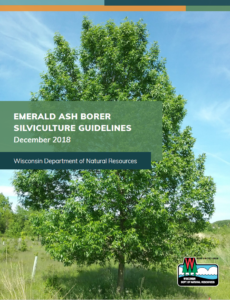 Continue reading “Updated emerald ash borer silviculture guidelines now available”
Continue reading “Updated emerald ash borer silviculture guidelines now available”
New insect and disease factsheets available
By Mike Hillstrom, forest health specialist, Fitchburg, Michael.Hillstrom@wisconsin.gov, 608-513-7690
The forest health team has produced four new factsheets since the start of 2020. These resources are designed to be informative, 2-page documents for a wide audience that includes landowners, foresters and natural resource professionals, educators, and more. The new factsheets of 2020 are linked below, and more will be announced as they are finalized:
Please check them out and our other recently updated factsheets about Heterobasidion root disease, oak wilt, conifer bark beetles, and hickory decline and mortality. You can find all of these and more forest health publications in the publications catalogue and on the DNR forest health webpage.
The Tick App! ‘Your Tick Expert On-The-Go!’
By Bieneke Bron, Midwest Center of Excellence for Vector-Borne Diseases, UW-Madison
Do you ever wonder why you are always finding ticks on yourself or around you, but your friends never do? Researchers at the University of Wisconsin – Madison have developed a mobile application that allows users to share their experiences with ticks to help prevent future tick bites.
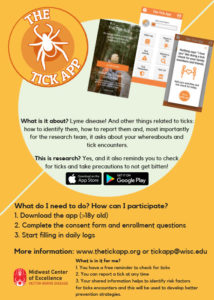 Continue reading “The Tick App! ‘Your Tick Expert On-The-Go!’”
Continue reading “The Tick App! ‘Your Tick Expert On-The-Go!’”
Native caterpillars not a major concern for trees
Mike Hillstrom, forest health specialist, Fitchburg, Michael.Hillstrom@wisconsin.gov, 608-513-7690
Eastern tent caterpillars (ETC) are hatching and beginning to feed on host trees in Wisconsin, including cherry, apple and crabapple trees. Landowners and homeowners may notice the white silken tents forming in branch forks. Although the tents are unsightly, ETC is a native insect and rarely causes damage. Even completely defoliated trees will put out new leaves within a few weeks.
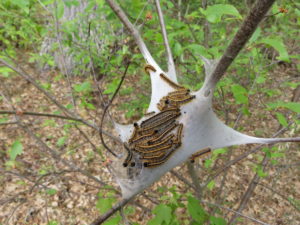
Eastern tent caterpillars preparing for a day of feeding on a black cherry tree.
Continue reading “Native caterpillars not a major concern for trees”
Larch casebearer and eastern larch beetle: two problems for tamarack
By Linda Williams, forest health specialist, Woodruff, Linda.Williams@wisconsin.gov, 920-360-0665
Tamarack trees are sending out their needles this spring, and larch casebearer caterpillars are feeding on them. In northern Wisconsin, where the trees didn’t push needles out until the end of May, the caterpillars were impatiently waiting to begin feeding and in some counties the damage is now severe.
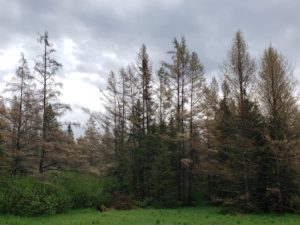
Tamarack trees defoliated by larch casebearer will appear straw-colored or tan from a distance. Photo taken May 28 in Oneida County.
Continue reading “Larch casebearer and eastern larch beetle: two problems for tamarack”
All about earthworms: nightcrawler edition
By Bernie Williams, invasive plants and earthworms specialist, Madison, Bernadette.Williams@wisconsin.gov, 608-444-6948
As the weather warms up and more of us are out in our gardens digging around, it seems like a good time to learn a few things about those fascinating and beautiful worms you keep encountering.
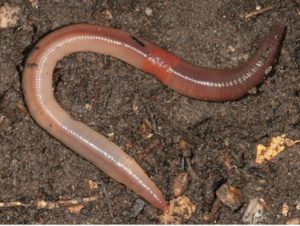
Nightcrawlers have reddish-pink bodies and can be 6-8 inches long when mature.
Continue reading “All about earthworms: nightcrawler edition”
What’s that orange goo?!
By Mike Hillstrom, forest health specialist, Fitchburg, Michael.Hillstrom@wisconsin.gov, 608-513-7690
What’s the orange goo on that tree?!
Should I fight or should I flee?
I bet forest health staff can ID!

The spore-producing, slimy, orange gall caused by cedar apple rust fungus.
